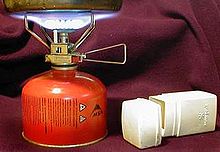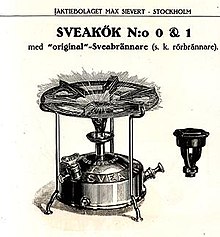Portable stove
Portable stoves can be used in diverse situations, such as for outdoor food service and catering[1] and in field hospitals.[2] Since the invention of the portable stove in the 19th century, a wide variety of designs and models have seen use in a number of different applications.He instituted many innovations, including cooking with gas, refrigerators cooled by cold water, and ovens with adjustable temperatures.The design of Soyer's "Magic Stove" was based on the same principle as a kerosene lamp, in which a wick is used to draw fuel from a tank or reservoir to a burner.MacGregor's 1866 book, "A Thousand Miles in the Rob Roy Canoe" was an international success and described his camping methods.The use of single burner alcohol stoves for camping, similar to the contemporary Trangia brand, was reported as early as 1919.So-called "white gas" or naphtha is commonly used as a fuel for camping and backpacking stoves, such as the compact Svea 123.The practice gained acceptance later in North America, and coincided with increased awareness of the environmental impact that campers and backpackers had on the areas where they travelled.Prior to their use, the usual practice when backpacking was to build an open fire for cooking from available materials such as fallen branches.The accumulation of fire scars in heavily travelled areas detracted from the pristine appearance that backpackers expected, leading to more widespread use of portable stoves.They are similar in function and ease of use to kitchen stovetops, usually with two burners set into a table-like surface, and often with a folding lid for stowage and wind protection.They remain popular for small boats owing to the minimal fire risk they pose in a confined space.Svensson, Lindqvist established the Primus brand of stove, which quickly developed into a worldwide market leader.The kerosene burning Primus stoves and their imitators were made of brass and were a significant advance over previous designs, which had used a wick to supply liquid fuel to the burner by capillary action.Primus-style stoves were made in a variety of sizes and styles, and many were designed to be disassembled for storage and transportation in a separate case.Outside of camping, single-burner stoves using cans of compressed butane gas are used for catering and other food service applications.[37] A solid-fuel stove may consist of no more than a metal base plate and container to hold the fuel, a set of legs to keep this assembly out of contact with the ground, and some supports for a billycan or other cooking vessel.[38] Generally intended for use by a single person, the fumes will tend to taint food if exposed to the burning tablets, and will also leave a messy residue that may be difficult to remove from cookware.Solid-fuel stoves produce a small amount of ash, and they can coat the bottoms of cooking vessels with tars and soot.More complex stoves may use a double-walled design with a chamber for partial biomass gasification and additional mixing to increase heat output and provide a cleaner, more complete burn.The advantage of these rocket stoves is their requiring little fuel, such as wood and dry weeds, to cook a meal, and with this less air pollution.The fuel is placed into a small chamber and, with the fan turned on, burns at a high heat output of 15,000 BTUs/hr (4.40 kW), about twice that of typical gasoline stoves.Ed Garvey, the noted Appalachian trail benefactor and multiple A.T. thru-hiker, carried a Zip stove with him when he hiked the A.T. at the age of 75.


















campingpicnickingbackpackingcookingcateringfield hospitalsshichirinEdo periodceramicdiatomaceous earthNorth AmericahibachiAlexis SoyerReform Clubkerosene lampCrimean WarBritish ArmyArmy Catering CorpsRoyal Logistic CorpsAlpinemountaineerFrancis Fox TuckettJohn MacGregorFridtjof NansenAdolphus GreelyTrangiaCarl Richard NybergPrimus stovesFrans W Lindqvistliquefied petroleum gasbutanemilitaryWorld War IIG.I. Pocket Stovegasolinewhite gasnaphthaSvea 123bicycle touringounceshorsebackultralight backpackersfonduealcoholSternobeverage can stovesbeverage cansmethylated spiritsKerosene heaterCatalytic heaterHumphry DavycatalysisPrimus stoveFrans Wilhelm LindqvistblowtorchPrimuspetrolmodern gasolineColeman CompanyGI pocket stoveMountain Safety ResearchmountaineeringcartridgepropaneSouth KoreaEN 417-specification Lindal valve cartridgesbarbecuesColemanColeman fuelbillycanhexaminehexamine stovetrioxanemetaldehydebiomassvalveschemical energyhobo stovebiomass gasificationrocket stoveAA batteryEd GarveyAppalachian trailthru-hikerFlash pointUnleaded automobile fuelPentaneOctaneflammabledistillationPot stillPetroleum spiritsbenzine, benzolineShelliteWhite spiritKeroseneDecaneDodecaneEthanolChafing fuelmethanoldiethylene glycolBeverage-can stoveBioLiteDutch ovenEcoZoomHistory of the portable gas stoveHot plateKelly KettleList of stovesOutdoor cookingWayback MachineHouston Chronicle